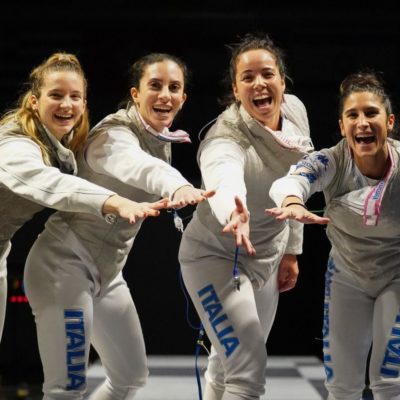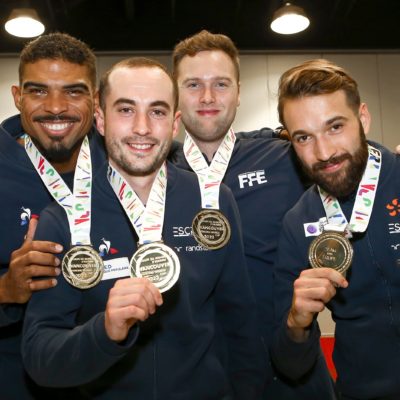by Dr. John Heil, Lewis-Gale Clinic, Department of Psychological Medicine
This script was developed from a series of sport psychology seminars in February 2002 with the Men’s Epee Team. It is a sport psychologist – athlete/coach collaboration using an "expert performer paradigm," in which coach and athlete are viewed as the primary experts in psychological knowledge of fencing.
The sport psychologist guides the athletes and coaches in identifying "intuitive" learning based on competitive experience, synthesizing this knowledge into a set of ideas, and creating a structure for practicing these ideas in a systematic fashion. In constructing this script, the sport psychologist blends established general concepts of mental training with the particular elements identified by athletes and coaches.
This is a prototype script, which reflects the general needs of those who participated in its development. It is designed to allows easy modification, in order to meet the particular needs of individual athletes.
The mental training exercise includes 8 sport scenarios – 3 scenarios related to preparation for competition, and 5 scenarios reflecting situations that may arise as competition unfolds. The specific situations included are those identified as most important by the seminar participants. Each scenario includes a "challenge situation" that is followed by a "psychological response" to that challenge. The particular "challenge situations" can be included or excluded at the preference of the athlete. In similar fashion, the "psychological response" to a given challenge can be changed to suit the athlete.
The length of the script can be varied, by increasing or decreasing the number of scenarios included. Any and all specific phrasing is modifiable. For example, if the phrase "Your mind’s eye" is not suitable or meaningful to an individual athlete it would be changed, for example, to "In your imagination…" or "Visualize…" or some other alternate phrasing.
For the fencer who did not not participate in the design of this script, the method serves as a sampler. It introduces a typical set of performance challenges, with a related set of potential reponses. More importantly, it demonstrates a method by which performance challenges may be addressed.
The language of the script is process oriented (focusing on proper skill execution), and avoids mention of specific outcomes ("results" oriented language; for example, mentioning a particular score or place). Expectation for specific results would be addressed independently as part of a goal-setting program.
The language of the script intentionally includes a substantial degree of repetition as this appears to help the mental training techniques become more deeply ingrained and therefore, more accessible under stress. However, variations are included intentionally (many of which are small and subtle). This creates a degree of novelty which is intended to make the mental training more interesting and appealing, and which reinforces the importance of making subtle modifications from situation to situation.
Reading the script as text, and experiencing it as a mental training exercise are fundamentally different. The purpose of mental training is to process thoughts and feelings in a different way, than is usually accomplished by sitting and reading. The essence of the difference is difficult to convey. Most simply put it is an intuitive-action based style of learning, in contrast to a rational- analytic style one.
JHeil
STRUCTURE
The underlying structure or "skeleton" of this mental training exercise, and the personalizing elements for "fleshing it out" follow.
Skeleton
• Introduction
o Goal statement
o Relaxation training
• Controlled breathing
• Muscle relaxation
• Quick relaxation
• Quick energizing
• Visualization
o Multisensory imagery
o Scenario #1 – Pre-competition: "Awaken from sleep"
• Situation & Reaction
o Scenario #2 – Pre-competition: "Warm up"
• Situation & Reaction
o Scenario #3 – Pre-competition: "First bout"
• Situation & Reaction
o Scenario #4 – Competition: "Relaxation"
• Distraction & Adjustment
o Scenario #5 – Competition: "Referee"
• Distraction & Adjustment
o Scenario #6 – Competition: "Energize"
• Distraction & Adjustment
o Scenario #7 – Competition: "Athletes choice"
• Distraction & Adjustment
o Scenario #8 – Competition: "Critical touch"
• Distraction & Adjustment
• Closing
o Reinforce goal statement
o Brief relaxation
o "Eyes open"
Personalizing Elements
Through a group process format, the athletes and coaches directly identified:
1. The goal statement – positive, focused, and relaxed — defining an ideal "Mind Set" for competition.
2. A set of challenge situations that are salient aspects of pre-competition preparation.
3. A set of typical distractions during competition, that was reduced to 5 for inclusion in the script.
4. A series of psychological responses to routine aspects of preparation for competition, and adjustments to typical distractions during competition.
Through the group process underlying themes were identified including:
1. The need to start strong with the first touch of the first bout.
2. The critical importance of making timely adjustments as the bout unfolds.
3. The need to use time between touches to make adjustments.
4. The importance of "being ready" when saying ready as the bout unfolds.
Distractions
• Bad call by referee
• Having lost a bout
• Taunting by opponent
• Crowd support for an opponent during a bout
• Preparing for a critical touch
• Brutality
• Deliberate late hits
• Long breaks in competition
• Negative thoughts
• "Other worries"
• Injury
• Fatigue
• The opponent gains momentum
• Losing or winning a string of touches
• Too tense
• Not intense enough
Sample Script
Becoming ready to fence — positive, focused, relaxed.
Begin by turning your attention to your breathing. Simply notice the way in which you breathe. Is it fast or slow, shallow or deep, rough & irregular, or smooth and regular.
Slowly, gradually allow yourself to come to a way of breathing that is slow, deep and regular; Slow, deep and regular. You will find that as you breathe in this way, your body will become calm and relaxed, your mind will become positive and focused. Calm and relaxed, positive and focused.
You can deepen your sense of calm and focus, by relaxing the muscles of your body, one set of muscles at a time. You can do this by counting from "1 to 10", and for each number you count, relaxing a particular set of muscles. To begin, breathe in count "1", focus on the muscles in your belly, then breathe out and relax your belly… Next, breathe in, count "2", focus on the muscles in your chest, then breathe out and relax your chest…Next, breathe in count "3", focus on the muscles in your back, then breathe out and relax your back… Breathe in count "4", focus on the muscles in your upper legs, breathe out, relax…Breathe in count "5", focus on the muscles in your lower legs, breathe out, relax…Breathe in count "6", focus on the muscles in your upper arms, breathe out, relax…Breathe in count "7", focus on the muscles in your forearms and hands, breath out, relax. Breathe in count "8", focus on the muscles in your neck and shoulders, breathe out, relax. Breathe in count "9", focus on the muscles in your face, forehead and head, breathe out, relax. Then breathe in count "10", focus on your entire body, breathe out and let yourself relax.
Breathing in a way that is slow, deep and regular; Slow, deep and regular. Your body is calm and relaxed, your mind is clear and focused. Calm and relaxed, clear and focused.
You can further deepen your feeling of calm and focus by slowly repeating "Down, Down, Down" silently to yourself as you breathe out. "Down, Down, Down" (Said slowly; exhaling through the mouth).
You can energize and intensify your focus by rapidly repeating, "Up! Up! Up!" silently to yourself as you breathe in. (Said quickly; inhaling through the nose).
Brief Pause
You can use your mind’s eye, the eye of your imagination to become ready to fence – to be positive, focused, relaxed.
Imagine that your mind is like a screen on which you can project any fencing situation.
Use your imagination to see the fencing venue, to see your opponents. Use your imagination to hear the sound of metal on metal, to hear the buzz of the machines. Think the thoughts and feel the feelings that come with this time and place. You are confident that you will be ready to fence – positive, focus, relaxed.
Brief Pause
Now your mind’s eye opens. Imagine you are waking up the morning of a competition.
As the drowsiness of sleep falls away, thoughts and feelings about the competition come to mind. You review your goals, as you look forward to the competition.
Your breathing is slow, deep, and regular… slow, deep, and regular. You are positive, focused and relaxed.
Brief Pause
Now your mind’s eye opens. Imagine you are at the venue, starting your warm-up. As you work through your warm-up, you patiently make the adjustments you need to be ready to fence when the competition begins.
Your breathing is slow, deep, and regular… slow, deep, and regular. You are positive, focused and relaxed.
Brief Pause
Now your mind’s eye opens. Imagine you are on the strip as the first bout is ready to begin. You are thinking only about fencing. You feel intense but not tense. When you say ready, you are ready.
Your breathing is slow, deep, and regular… slow, deep, and regular. You are positive, focused and relaxed.
Brief Pause
You are confident that you will be ready when each bout begins. You are confident that you will deal with distractions. You are confident that you will make the adjustments you need to make to fence your best.
Brief Pause
Now your mind’s eye opens. As the bout develops you are beginning to feel more and more tense. You pause for a moment, and use a brief relaxation technique. As you do you feel more and more calm, more and more relaxed.
When you say ready, you are positive, focused and relaxed.
Brief Pause
Now your mind’s eye opens. The referee has made a bad call. You pause for a moment, and think through the situation. You decide whether to interact with the referee, or to let it go. Then you are done with it.
When you say ready, you are positive, focused and relaxed.
Brief Pause
Now your mind’s eye opens. You find yourself starting to feel sluggish, tired. You pause for a moment and use an energizing technique. You fell your energy build and build. You fell more and more energized.
When you say ready, you are positive, focused and relaxed.
Brief Pause
Now your mind’s eye opens. Something has happened to distract you. You pause for a moment and consider the solution. As you work on the adjustment, you feel your confidence grow. You become more and more confident.
When you say ready, you are positive, focused and relaxed.
Brief Pause
Now your mind’s eye opens. You are at a critical point in the bout. You pause for a moment and consider your next action. Once you decide on plan, you resolve to "prepare and go." You are ready to act decisively.
When you say ready, you are positive, focused and relaxed.
Brief Pause
Now take a moment to look forward to your next competition.
Use your imagination to see the fencing venue, to see your opponents. Use your imagination to hear the sound of metal on metal, to hear the buzz of the machines. Think the thoughts and feel the feelings that come with this time and place.
Brief Pause
You are confident that you will be ready when each bout begins. You are confident that you will deal with distractions. You are confident that you will make the adjustments you need to make to fence your best. Then let the picture of the competition in your mind’s eye fade away, little by little.
Your body is calm and relaxed, your mind is clear and focused.
Brief Pause
Now take a moment to rest. Begin by turning your attention to your breathing. Simply notice the way in which you breathe. Is it fast or slow, shallow or deep, rough & irregular, or smooth & regular. Slowly, gradually allow yourself to come to a way of breathing that is slow, deep and regular; Slow, deep and regular. As you breath in this way you become calm, comfortable and relaxed, calm, comfortable and relaxed.
Pause
Now be aware of your surroundings. Ready in a moment to open your eyes.
With a count backwards from "10 to 1", you feel yourself grow more alert and relaxed as you remain calm, focused and confident. 10, 9, 8, 7, 6, 5, 4, 3, 2, 1. Eyes open.
This technical report was prepared under the direction of the United States Fencing Sports Medicine & Science Committee (USF SM&S) on behalf of its membership. While the report is specific to Men’s Epee the concepts and methods are applicable to all fencers. The USF SM&S would like to express his appreciation to Lewis-Gale Clinic for its support in this project. This report is the product of a series of training seminars with the Men’s Epee team. Contributing to its development are: Paul Soter, Marcos Lucchetti, Nat Burke, Eric Hansen, Keith Lichten, Mike Lyons, Cody Mattern, Jeff Snider, and Marcus White.
It is being made available to the general membership, in keeping with the mission of the Sports Medicine & Science Committee, which is to both enhance the competitiveness of elite athletes and to serve the general membership.
Reference Citation: Heil, J. (2002).
Psychological Preparation for Competition: The Men’s Epee Team Mental Training Protocol (United States Fencing Association Technical Report (No. 2002-01). Colorado Springs, CO: United States Olympic Training Center. The report is available on the United States Fencing Association Web Site at: www.usfencing.org
For more information, you may contact the author at: [email protected]





